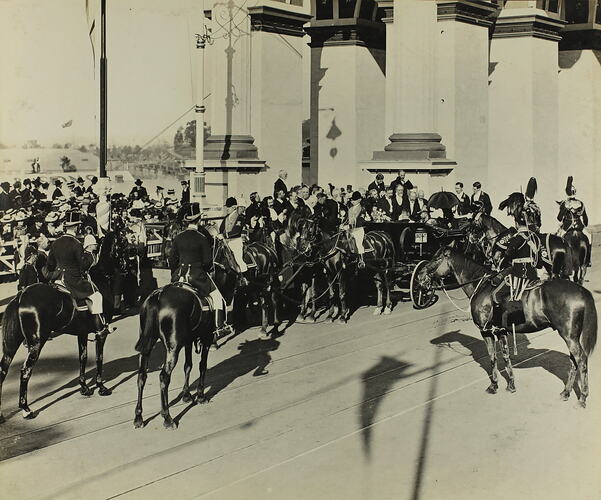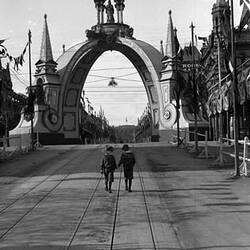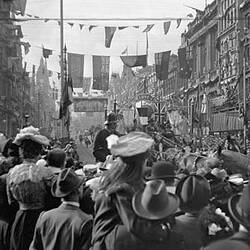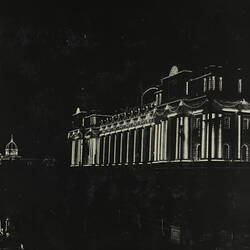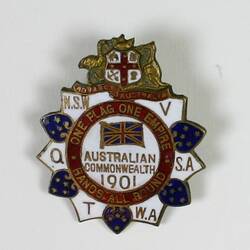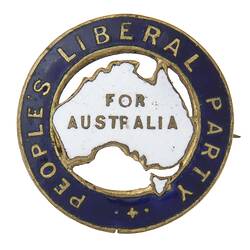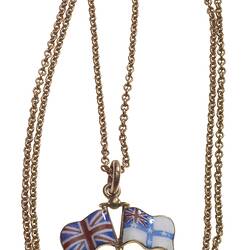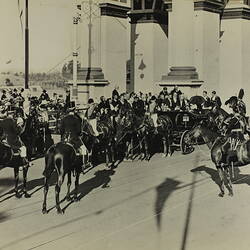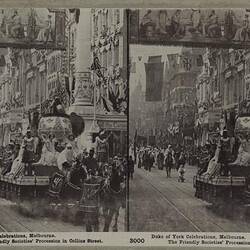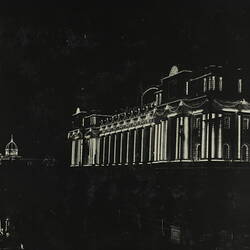Summary
The Commonwealth of Australia was inaugurated on 1st January 1901 in Centennial Park, Sydney. In March, elections were held for the new Federal Parliament, and in May the celebrations focused on Melbourne, where the first Federal Parliament was opened in the (Royal) Exhibition Building. This narrative describes the street parades and public celebrations held during Federation festivities in Melbourne.
'...down the narrow obscure lanes, in the humble homes of the poor, the loyal citizens had each done their best to play a part in the demonstration. By day, if it were only a tiny twopenny flag, it was something ... By night, a candle-lit kerosene tin, punched with holes to form a map of Australia [or] a crown...' (The Age, 7 May 1901)
The festivities of May 1901 were a spectacular way to celebrate the founding of a new nation - the Commonwealth of Australia.
Melbourne and towns around Victoria decorated buildings and streets. Public holidays allowed people to flock to Melbourne for a glimpse of the Duke and Duchess of Cornwall and York, or to wander along the streets looking at the ceremonial arches and listening to the bands playing around the city.
In the evenings, while official guests were entertained with receptions, concerts and dinners, the Melbourne public could enjoy fireworks, music, processions and a military tattoo. Public buildings, ships in the bay and street arches were illuminated with strings of electric lights.
Official Events and Invited Guests
The 12,000 guests invited to the opening ceremony were mostly from Australia or New Zealand. More than half were Victorians. Around 1700 invitations were issued to Australasian Parliamentarians, and another 1500 to municipal representatives. Other dignitaries included international representatives, consuls, judges, and Naval and military officers. When we first look at the images of the event, it seems as if only men were at the opening of Federal Parliament, but a closer look reveals women and even a few children.
On the streets
The streets of Melbourne were full of people wanting to participate in the festivities or enjoy their holidays. The Warnambool Standard reported on the 8 May 1901: 'The streets, or at any rate, Spring, Collins, Bourke and Elizabeth streets, were crowded to excess. In places, locomotion was so difficult that it took a quarter of an hour to travel a hundred yards .... Old and young - all were out for the evening. Devoted sons or daughters piloted aged and feeble parents, mothers carrying babes in arms deserved and won sympathy, and the affectionate fathers who led children through the throng had an anxious time.'
Decorations
Large temporary arches were erected by Chinese and German communities, the dairy industry, councils and the state government. The Citizens Arch was funded through public subscription. Committees of residents and businesses took on responsibility for decorating sections of the city. Individual businesses and private homes were also decorated. There was both praise and criticism for the decoration of the city. The Weekly Times reported: 'While some people are saying, 'What a waste of money,' others of a more philosophical mind, point to the decorative effect with genuine satisfaction.... Certainly, much of the money expended has gone direct into the pockets of the workers. For weeks quite a small army of people have been engaged in shaping...ornamental devices.'
Processions
People travelled from all over Victoria to participate in a range of processions. There were two main royal processions, one on the arrival in St Kilda of the Duke and Duchess, and one along the route to the opening of Parliament at the Exhibition Building. The royal couple rode in an open carriage for the huge crowd to see them.
The Stockman's Procession and display of 'rough riding', on 7 May, involved around 200 stockmen from all parts of Victoria, including the Mallee, the Western District, the Riverina and the Gippsland region. The Argus described the procession: 'As they rode along with their stock whips cracking like the rattle of a Maxim gun, and the cooees passing from front to rear, a loud and spontaneous cheer arose from the immense crowds that lined the route of the march.'
On the same day there was a Chinese procession beginning in Little Bourke Street. It included Chinese dragons, and bands playing Chinese music. Newspapers often represented the Chinese community as exotic and strange. In April, the Argus had reported: 'The Chinese residents of the city are making great preparations for their procession, which has been fixed for Tuesday May 7. All the strange properties and mysterious paraphernalia which made past processions so weirdly attractive are being furbished up anew, while a number of gorgeous costumes and banners, just arrived from China, will be used for the first time.'
After the procession, the Riverine Herald described the procession: 'The two dragons were wonderful and marvellous constructions, hundreds of feet long, and wriggling in a most diabolical manner, with mouth open and the ears flapping to and fro.'
That evening around 1300 firemen, mostly from the Country Fire Brigades, took part in the Fire Brigades' Torchlight Procession. Each fireman held a lit torch, a spectacular sight for the crowds that lined the streets. The description in the Argus conjures up what it must have been like: 'At times the brightness of the stream of light on street level shot up the side of the buildings ... A curious effect was produced wherever this occurred. As the Venetian masts and the festoons of flags were between the light of the procession and the high grey walls of the streets, strange fantastic shadows flitted and danced in the yellow glare until it seemed that the whole place was a mass of fluttering flags and poles.'
On 11 May the Trades and Friendly Societies Procession was conducted. It featured fifteen friendly societies (representing around 100,000 members), Eight-hour Day committees and a diverse range of 77 different trade unions. The trades included tailoresses, ironmoulders, cigar makers, hairdressers' assistants, felt hatters and felt hat trimmers and binders, milkmen, clerks, bookbinders, professional orchestral musicians, undertakers' assistants, quarrymen, soap and candle makers, confectioners, glass blowers, stevedores, coach-makers and bakers. Interspersed were various marching bands, including the East Brunswick Brass Band, the Collingwood Imperial Band, The Yarraville Band, Sim's Fitzroy Military Band and the South Melbourne Military Band.
More Information
-
Keywords
-
Authors
-
Article types
